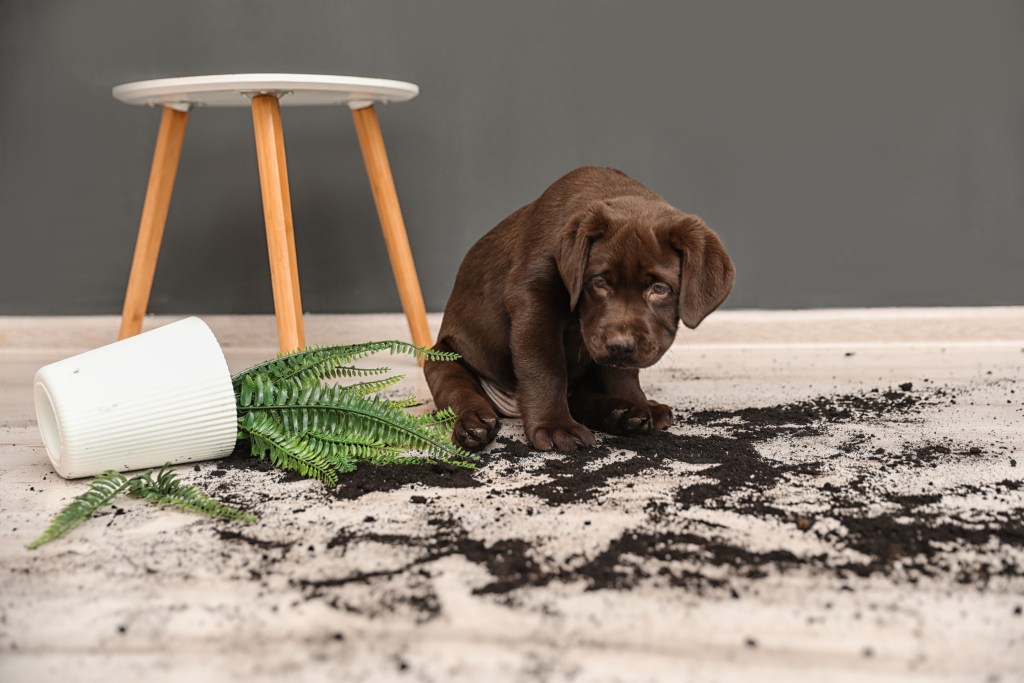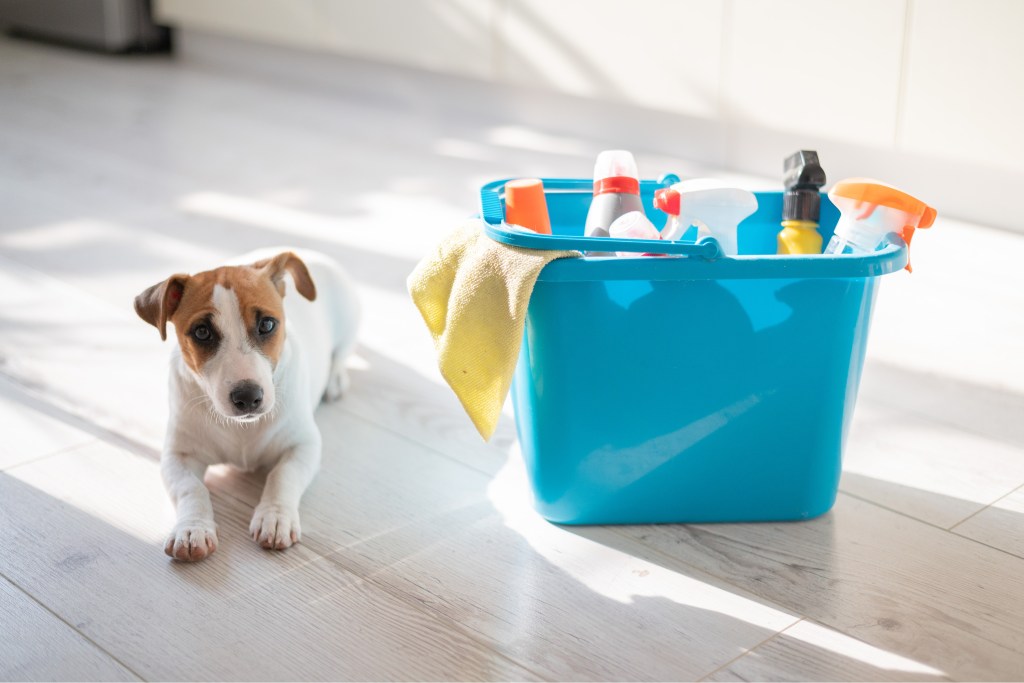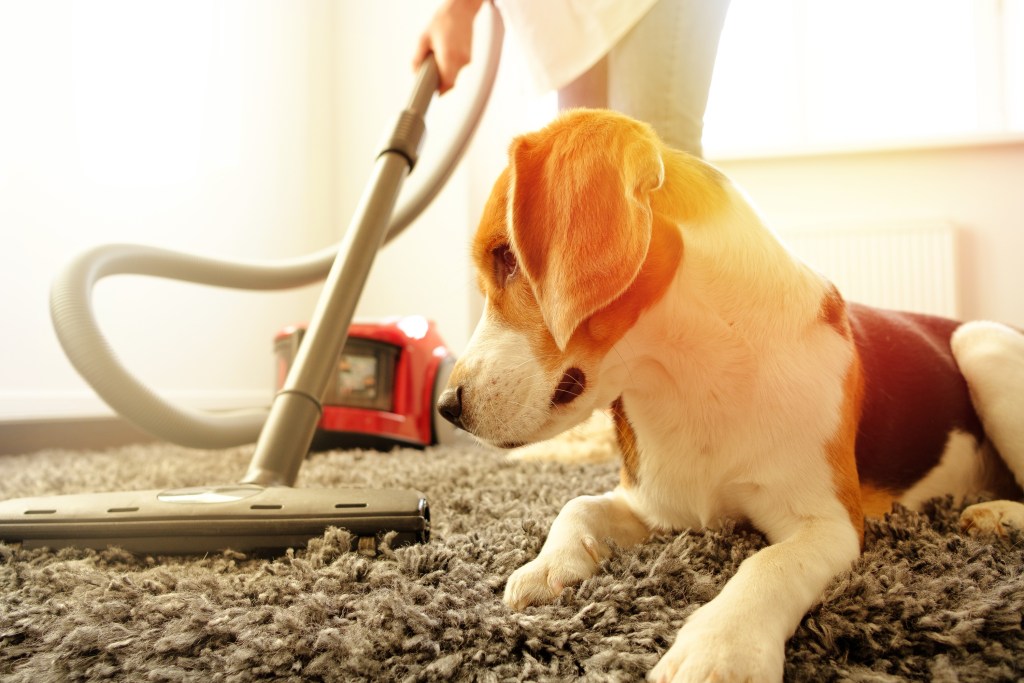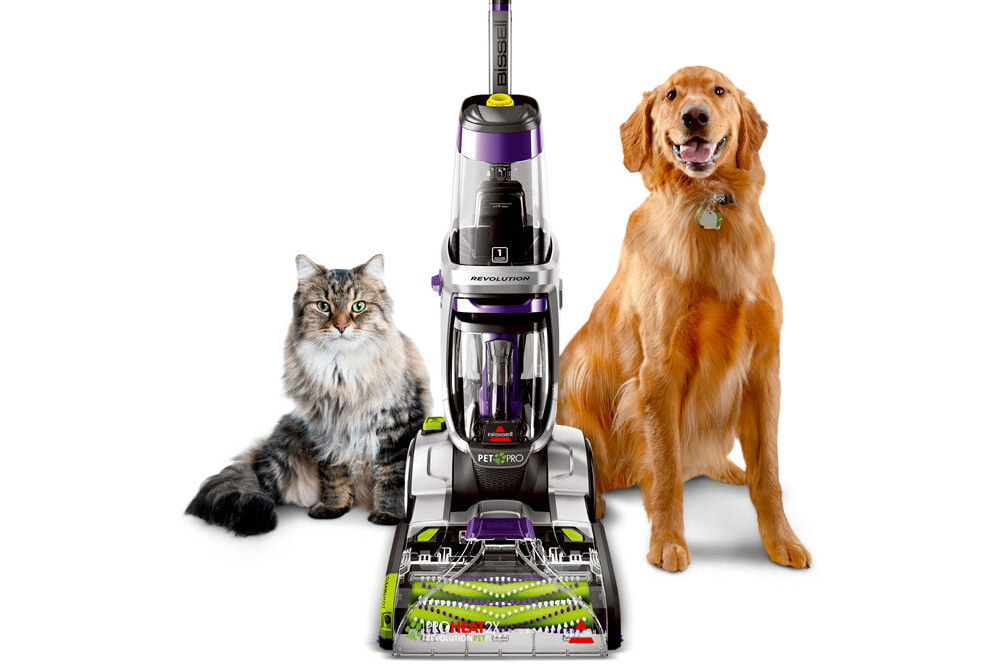One of the many responsibilities of being a pet parent involves cleaning up the messes your dog or cat manages to create. Whether it’s pee, poop, puke, fur that’s been shed, paper that’s been shredded, or items that have been chewed apart, maintaining a clean home can be an ongoing challenge.

First, figure out your needs
Many pet parents have discovered their own unique solutions for cleaning up the many types of messes their pet(s) are responsible for. To ensure you’re ready for the challenge, first, evaluate your home and determine what types of surfaces you’ll need to keep clean. Most homes contain:
- Carpeting and/or area rugs
- Laminate and/or tile flooring
- Hardwood flooring
- Upholstered (fabric covered) or leather furniture
Each of these surface types requires different tools and cleaning products to maintain and keep clean. Once you determine what you need to keep clean, next focus on your pet(s) and figure out the types of messes they’re most apt to create. This, too, will determine the types of cleaning tools and products you’ll need to keep on hand.
- If you’re purchasing new carpeting for your home, be sure to invest in the highest quality stain protection offered. For carpeting that’s already installed, before messes are created, you can apply a chemical treatment, such as Scotchgard from 3M, which is designed to infiltrate a carpet’s fibers and then block stains so they can’t set in. This will make cleanups much easier in the future.
- When purchasing an area rug, be sure to find ones that are machine washable. However, follow the cleaning instructions carefully, as cotton rugs will shrink in the dryer. Several companies, like Ruggable and Rugs USA, offer pet-friendly area rugs that are much easier to keep clean and sanitary than traditional area rugs.
- Next, consider what additional precautionary measures you can take to make clean-ups easier. For example, keeping a covering on your furniture when it’s not in use by humans in order to reduce shed pet hair collection, or training your dog to use pee pads instead of your carpeting when you’re not able to take them outside. If you’re a cat owner, investing in a quality litter box and cat litter and then training your cat to use it will help control pet-related stains and smells. The more often you clean your cat’s litter box, the easier it’ll be to control the unwanted odors in your home.
The cleaning tools you’ll likely require
Once you know what types of surfaces you’ll need to keep clean and the types of mess-related challenges your pet(s) will create for you, consider the cleaning tools you’ll need. A typical home will need a traditional vacuum cleaner designed to suck up pet hair (and other dirt) and some type of mop for non-carpeted flooring. However, you’ll discover there are plenty of specialty cleaning tools that are “must-haves” for pet parents, such as a portable, battery-powered carpet/upholstery cleaner and a handheld vacuum for smaller messes.
For cleaning up pee, poop, puke, and spills from carpet and upholstery, a tool like the Bissell Pet Stain Eraser PowerBrush Plus Portable Carpet Cleaner makes cleaning up a carpet messes quick and easy and is much less cumbersome than a full-size carpet shampooer.
Meanwhile, if pet hair is a constant problem, tools like the Bissell Pet Hair Eraser Corded Handheld Vacuum or the Dyson v11 Animal are ideal for smaller areas, furniture upholstery, and staircases, for example.
The following companies all offer full-size vacuums for carpets and hard floor surfaces that will help keep dirt and pet hair under control, along with separate carpet shampooers and/or steamers for cleaning, disinfecting, and deodorizing carpets:
Prices for these cleaning tools vary greatly. Keep in mind, in some cases, you’ll pay higher prices for brand names (like Dyson), as opposed to enhanced features and functionality, so pay attention to customer ratings and reviews. Many consumers who can’t afford Dyson cleaning tools find less costly yet equally powerful tools from Shark, for example, offer a better value. You’ll definitely want to do your homework based on your cleaning needs.

Select the right cleaning products for the mess at hand
Having the right cleaning tools available is only the first step to maintaining a clean home. Next, you’ll need to choose specific cleaning products, like a floor cleaner and carpet/upholstery shampoo, as well as a pet stain remover, an enzyme-based urine destroyer, and/or an odor remover. It’s essential that you use products that are pet-friendly and don’t contain ingredients that can be harmful to your pet if inhaled or consumed. At the same time, it’s important to choose cleaning products that clean, deodorize, and disinfect, as well as remove stains — not just mask smells.
Depending on the type of mess you need to clean up, the following pet-friendly products will be useful, although this is just a small sampling of what’s available from your favorite pet superstore or online. Keep in mind, for some messes, more than one cleaning product may be required.
The following cleaning products contain no harsh chemicals or perfumes that simply mask odors:
- Furry Freshness: A liquid-based stain and odor remover that can be applied directly to carpeting or upholstery, or used within a carpet/upholstery cleaning tool. This company offers separate formulas for dog- and cat-related messes.
- OxiClean: A powder-based stain remover that gets mixed with warm water and applied directly to carpet or upholstery. It can also be used within most carpet/upholstery cleaning tools or shampooers.
- Nature’s Miracle: This company offers a complete line of liquid-based stain removers, odor eliminators, and urine destroyers that are pet-friendly. The products can be sprayed directly on stains or used within a carpet/upholstery cleaning tool.
- Skout’s Honor: This company also offers a line-up of liquid-based cleaning, deodorizing, and stain removal cleaning products, with separate products specifically formulated for dog- and cat-related messes.

Pet experts share their cleaning tips
There are plenty of pet parents who create their own cleaning solutions that are pet-friendly, chemical-free, and perfume-free.
For example, Tim Mitchum, founder of WINPRO Pet, explains, “One way to remove pet-related messes involves the following simple tools: a lint-free cleaning cloth, a combination of one cup of scented vinegar and lukewarm water in a spray bottle, and a stain brush. First, blot up any liquid with the cleaning cloth. Next, spray the affected area with the water-vinegar solution and let it sit for between 10 and 15 minutes. If necessary, use a stain brush to work the solution in. After 10 to 15 minutes, blot the area with a moistened lint-free cleaning cloth.”
Lauren Spencer, from The Spoilt Canine, uses a similar homemade cleaning formula. She says, “You can make your own dog wee spray using everyday household ingredients. Use Vinegar, water, and two teaspoons of baking soda. Let it sit on the stain for a few minutes, and then blot with towels until clean.”
Dr. Maureen K. Murithi, a veterinarian with ExcitedCats.com, offers this advice for cleaning pet stains from a carpet or hard surface floor: “Pour cold water on the stain and bolt dry with a paper towel. Next, apply a carpet cleaner, such as Bissell Spot & Stain Pet Formula, and then rinse thoroughly with cold water. Add a few drops of disinfectant and blot dry again. On hard surface flooring, add a few drops of fragrant essential oil, such as peppermint, to vinegar, and then clean the area with the vinegar mixture. Stale cat urine odor can linger for some time and may be difficult to eliminate. Applying an enzyme-based cleaner that’s formulated for pet urine is advised.”
When it comes to cleaning up poop, environmentally conscience pet parents tend to use earth-friendly (biodegradable) poop bags to collect and then throw away their pet’s feces. Jake Romano, the Systems Manager at John the Plumber, says, “We’ve seen people scoop up several days’ or weeks’ worth of dog poop from their yard at once, for example, and flush it all down the toilet at the same time. This can be a big mistake. While I believe that flushing a single poop is convenient, I would recommend against flushing larger amounts, especially if it’s dried. When dog poop dries, it loses its malleability, and it can cause some stubborn clogs in your drain system.”
You’ll typically have the easiest time cleaning up pet-related messes while they’re still fresh, so having the right tools and cleaning products on hand will make your life much easier. This will also help prevent odors and stains from seeping into porous materials, such as carpets and upholstery, and then drying, which makes them much harder to remove.




